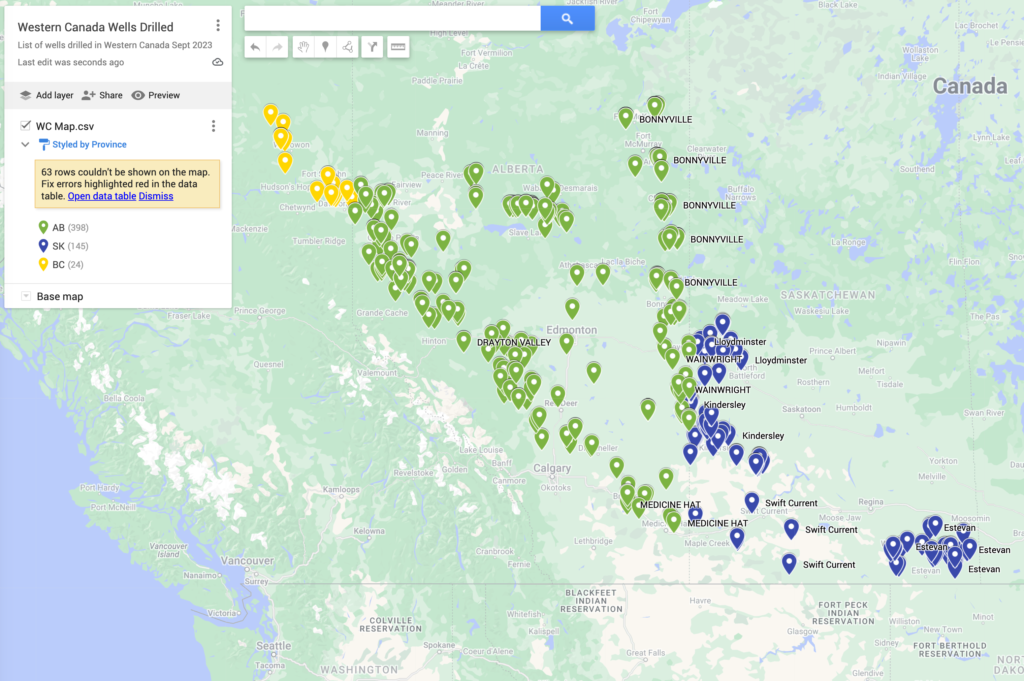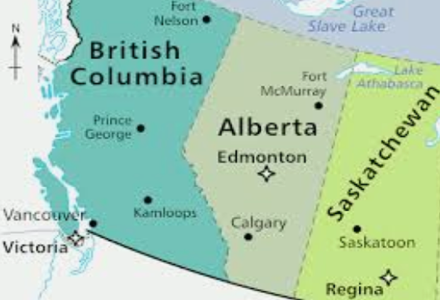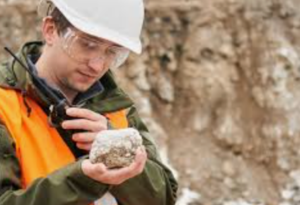The Western Canada oil and gas industry refers to the sector involved in the exploration, production, refining, and distribution of oil and natural gas in the western provinces of Canada. The industry is a significant contributor to the Canadian economy and plays a crucial role in global energy markets.

Oil & Gas Data Download Center

Wells Drilled 2024
Detailed list of wells deilled in Western Canada YTD 2024
Oil & Gas Operators
Detailed list of active Oil & Gas Operators in Western Canada
Wells Drilled Western Canada
Detailed list of wells drilled last 12 months in Western Canada
Western Canada Active Rigs
Detailed list of active drillings reigs in Western Canada Last 30 days
Western Canada Wells Drilled Map (click to access)
Map of wells drilled in Western Canada for the month of Sept 2023

Canada Oil & Gas Industry
Canada’s energy sector, historically dominated by hydroelectric power, has seen significant growth in oil and natural gas production, particularly in Alberta, while Quebec and British Columbia focus on hydroelectric and renewable energy. The sector contributes significantly to the economy, accounting for 11.8% of GDP and 3.5% of employment in 2022, with recent infrastructure projects like the Trans Mountain Expansion (TMX) Pipeline aiming to enhance export capabilities. Canada is also implementing numerous policies to transition to lower carbon fuels, including a proposed cap-and-trade system to achieve net-zero emissions by 2050.
Petroleum and Other Liquids in Canada
As of January 2024, Canada held 163 billion barrels of proved oil reserves, ranking fourth globally, with oil sands accounting for 97% of these reserves. In 2023, Canada was the fourth-largest global producer of petroleum and other liquids, producing 5.8 million barrels per day (b/d), primarily from Alberta’s oil sands. While the majority of Canada’s petroleum exports go to the United States, its refineries, concentrated in Alberta and Ontario, have a nameplate capacity of 1.7 million b/d, processing crude oil into essential products for transportation and heating, but most of Alberta’s diluted bitumen is exported due to limited domestic refining capabilities.
Natural Gas and LNG in Canada
Canada’s proved natural gas reserves are estimated at 87 trillion cubic feet (Tcf) as of January 2024, primarily located in the Western Canadian Sedimentary Basin (WCSB), with significant reserves also found offshore and in the Arctic region. In 2022, Canada was the world’s fifth-largest natural gas producer, generating 6.6 Tcf of dry natural gas, with production mainly concentrated in British Columbia and Alberta, which accounted for 98.7% of the total output.
Natural gas consumption in Canada has grown at an average annual rate of 2% from 2012 to 2022, with 4.6 Tcf consumed in 2022, primarily by the industrial, residential, and commercial sectors. The country is developing eight LNG export projects, with LNG Canada in Kitimat set to become the first large-scale export facility by 2025, while other projects are expected to commence between 2027 and 2030.
Additionally, Canada is transitioning from coal to natural gas-fired power plants, with 18 new facilities in planning or approval stages and four under construction, supporting the government’s goal to phase out coal for power generation by 2030.
Energy Trade in Canada
Canada is a net energy exporter, with the United States as its primary trading partner, receiving 90% of Canada’s 2022 energy exports valued at $240.5 billion. Oil and natural gas dominate these exports, making up 90% of the total, while Canada’s energy imports amounted to $65.3 billion.
In 2023, Canada exported 92% of its crude oil to the United States, which relies heavily on Canadian oil, particularly in the Midwest and Rocky Mountain regions. Additionally, Canada exported 3.1 Tcf of natural gas, all to the U.S., and 52 terawatthours of electricity, primarily from hydropower sources.
Oil & Gas by Province
Alberta
The Alberta oil and gas industry is a significant sector within the province of Alberta, Canada, primarily focused on the exploration, extraction, production, refining, and distribution of oil and natural gas resources. Alberta is a major player in the global energy market due to its extensive oil reserves, particularly in the form of oil sands, as well as substantial natural gas resources.
Here are key aspects of the Alberta oil and gas industry:
- Oil Sands: Alberta is renowned for its vast reserves of oil sands, a mixture of sand, clay, water, and heavy oil known as bitumen. The Athabasca Oil Sands in northern Alberta are one of the largest known oil sand deposits in the world. Extracting and processing bitumen from oil sands is a significant component of Alberta’s oil production.
- Conventional Oil and Gas: In addition to oil sands, Alberta has significant reserves of conventional crude oil and natural gas. The province is a major hub for conventional oil and gas drilling and production, with various oil fields and gas reserves located throughout the region.
British Columbia
The British Columbia (BC) oil and gas industry refers to the exploration, extraction, production, refining, and distribution of oil and natural gas resources in the province of British Columbia, Canada. While not as prominent as Alberta in terms of oil production, BC has significant natural gas reserves and emerging oil developments.
Here are key aspects of the British Columbia oil and gas industry:
- Natural Gas Reserves: British Columbia has substantial natural gas reserves, primarily located in the northeast region of the province, including the Montney and Horn River basins. Natural gas is a vital component of BC’s energy sector and is used for various purposes, including electricity generation, heating, and industrial processes.
- LNG (Liquefied Natural Gas) Development: British Columbia is actively pursuing the development of LNG facilities to export liquefied natural gas to international markets, particularly Asia. The LNG Canada project in Kitimat is a major example of this initiative, attracting significant investment and contributing to the province’s economic growth.
- Emerging Oil Opportunities: BC also has potential for conventional and unconventional oil resources, including light and heavy crude oil. The emerging oil industry is mostly focused in areas like the Montney formation, which holds both oil and gas resources.
Saskatchewan
The Saskatchewan oil and gas industry refers to the exploration, extraction, production, refining, and distribution of oil and natural gas resources in the province of Saskatchewan, Canada. Saskatchewan is a significant player in the Canadian energy sector and has substantial reserves of both conventional and unconventional oil and natural gas.
Here are key aspects of the Saskatchewan oil and gas industry:
- Conventional Oil and Gas: Saskatchewan has substantial reserves of conventional oil and natural gas. Conventional oil is extracted using traditional drilling methods, while natural gas is extracted from gas reservoirs. The province has multiple oil fields and gas basins contributing to its oil and gas production.
- Heavy Oil and Bitumen: Saskatchewan has significant reserves of heavy oil and bitumen, which are less viscous than oil sands bitumen but require specialized extraction and processing techniques. The Lloydminster region is known for its heavy oil production.
- Economic Impact: The oil and gas industry is a crucial economic driver in Saskatchewan, contributing significantly to government revenue, employment, and overall economic growth. It supports a wide range of jobs directly and indirectly, including drilling, extraction, transportation, and support services.
- Enhanced Oil Recovery (EOR): Saskatchewan is known for employing Enhanced Oil Recovery (EOR) techniques to increase the recovery of oil from mature oil fields. Methods such as steam injection and carbon dioxide flooding are commonly used to enhance production from reservoirs.
Contact Lists



